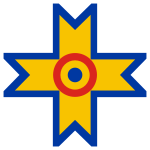  |
| History |
|---|
| Royal Romanian Air Force |
| List of WWII flying aces |
| Aircraft |
| List of Romanian Air Force aircraft |
| Structure |
| List of Air bases |
| List of squadrons/other units |
| Personnel |
| Officer ranks |
The Forţele Aeriene Regale ale României (Royal Romanian Air Force, FARR), or simply Forţele Aeriene Române (Romanian Air Force) was the Air Arm of Royal Romanian forces in World War II. It provided support to land forces, carrying out reconnaissance and mounting air raids between other missions.
Insignia[]
The insignia of the FARR was a yellow cross (Michael the Brave cross) in the fuselage and upper and lower wings, and the national colours on the tail, with a yellow engine cowling and vertical band on the fuselage. It was later changed at tricolor (red-yellow-blue) roundels on the fuselage and wings, and a tricolor band on the tail.
History[]

Aircraft marking during 1941-44 period
FARR flew aircraft from Germany and Italy, with their own and other foreign aircraft, as well as captured enemy aircraft. The Romanian Air Force fought against the Magyar Királyi Honvéd Légierö (Hungarian Air Force) during the Hungarian annexation of Transylvania. The most basic unit of their formations was the squadron (Grup). The Romanian Air Force fought alongside the Luftwaffe during the advance into the Ukraine and Crimea, until the Battle of Stalingrad, when the Southern Luftwaffe Command was installed in Bucharest. It also carried out some reconnaissance and patrol missions over the Black Sea alongside Bulgarian units. The Romanian Air Force was tasked with the air defence of the Ploieşti oil installations, and also Bucharest against Allied air raids, and to protect Axis convoys in the Black Sea. These units fought against the USAAF and RAF during their raids against Romania.

A preserved German Junkers Ju 88 in the National Museum of the United States Air Force, painted with the Romanian markings it carried during World War 2
The main models of aircraft used include the PZL P.24F, Hawker Hurricane, Heinkel He 112, Messerschmitt 109E and G types, Messerschmitt 110 (for night defence), IAR 80A were used too, alongside other types of interceptors used by the Luftwaffe units in area.
When the country was invaded by Soviet forces, King Mihai I (Michael) ordered Romanian forces to attack Axis forces, and the FARR was allied with Soviet Voenno-vozdushniye Sily against German and Hungarian forces in Transylvania and Slovakia, though some units continued to fight with the Axis in Luftwaffe volunteer units.
Romanian Air Aces[]
- Horia Agarici
- Constantin Cantacuzino
- Cristea Chirvăsuţă
- Ion Di Cesare
- Tudor Greceanu
- Ioan Maga
- Ioan Mălăcescu
- Ion Milu
- Ioan Mucenica
- Constantin Lungulescu
- Alexandru Şerbănescu
Structure[]
- Grupul 3° Picaj, Corpul 2° Aerian, Luftflotte 4, South Russia Front, Winter of 1943-44.
- Grupul 3° Picaj, Corpul 1° Aerian, Cioara, Dolcesti, Romania August 1944; under orders of Luftwaffe, Luftflotte Kommando 4 with commands in Debrecen, Hungary
- 6th Fighter Group
- 7th Fighter Group
- 8th Fighter Group (1941–1943)
- 9th Fighter Group
- 5th Bomber Group
Aircraft companies[]
- Societatea Pentru Exploatări Tehnice (SET), 1923, Bucharest
- Industria Aeronautică Română (IAR), 1925, Braşov
- Întreprinderea de Construcţii Aeronautice Româneşti (ICAR), 1932, Bucharest
Aircraft constructed under foreign license
- Heinkel He 111 H (30 examples by Brasov)
- Messerschmitt Bf 109G (75 IAR built 109G-6a examples by Brasov)
- Savoia-Marchetti SM.79JR (16 examples by Brasov)
- PZL P.11f (80 examples by IAR)
- PZL P.24E (50 examples by IAR)
- IAR 36 (Messerschmitt design) (5 examples by IAR)
Enemy aircraft interned or captured[]
As a result to the Soviet Invasion of Poland, a large number of Polish Air Force aircraft were interned in Romania. Also, some Soviet were captured during WWII, as well as few American B-24 Liberator bombers.
Aircraft of RRAF[]
External links[]
| |||||||||||||
| |||||||||||
The original article can be found at Royal Romanian Air Force and the edit history here.
